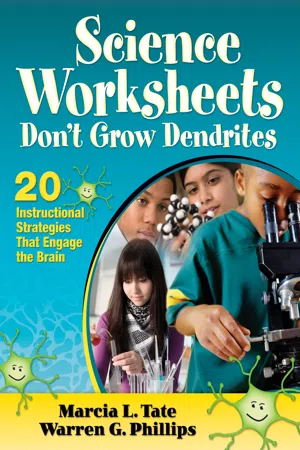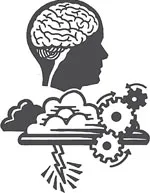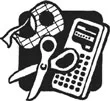
eBook - ePub
Science Worksheets Don't Grow Dendrites
20 Instructional Strategies That Engage the Brain
This is a test
- 192 pages
- English
- ePUB (mobile friendly)
- Available on iOS & Android
eBook - ePub
Science Worksheets Don't Grow Dendrites
20 Instructional Strategies That Engage the Brain
Book details
Book preview
Table of contents
Citations
About This Book
A brain-friendly guide for motivating students to live, eat, and breathe science!
The authors outline 20 proven brain-compatible strategies, rationales from experts to support their effectiveness, and more than 250 activities for incorporating them. Teachers will find concrete ways to engage students in science with visual, auditory, kinesthetic, and tactile experiences that maximize retention, including:
- Music, rhythm, rhyme, and rap
- Storytelling and humor
- Graphic organizers, semantic maps, and word webs
- Manipulatives, experiments, labs, and models
- Internet projects
Frequently asked questions
At the moment all of our mobile-responsive ePub books are available to download via the app. Most of our PDFs are also available to download and we're working on making the final remaining ones downloadable now. Learn more here.
Both plans give you full access to the library and all of Perlego’s features. The only differences are the price and subscription period: With the annual plan you’ll save around 30% compared to 12 months on the monthly plan.
We are an online textbook subscription service, where you can get access to an entire online library for less than the price of a single book per month. With over 1 million books across 1000+ topics, we’ve got you covered! Learn more here.
Look out for the read-aloud symbol on your next book to see if you can listen to it. The read-aloud tool reads text aloud for you, highlighting the text as it is being read. You can pause it, speed it up and slow it down. Learn more here.
Yes, you can access Science Worksheets Don't Grow Dendrites by Marcia L. Tate, Warren G. Phillips in PDF and/or ePUB format, as well as other popular books in Education & Teaching Science & Technology. We have over one million books available in our catalogue for you to explore.
Information
Strategy 1
| Brainstorming and Discussion |  |
| WHAT: DEFINING THE STRATEGY |  |
Which substance has the highest pH value?
Why do finer steel wools burn much longer than thicker ones?
Why will a paper clip float on water?
How do lasers work?
Of all the content areas, science is probably the one that most naturally lends itself to finding answers to relevant questions. When a science teacher arouses the natural curiosity of students’ brains through meaningful questioning, discussing the answers to those questions and brainstorming ideas become natural parts of any lesson.
Try the following activity as one that will cause students to think outside the box, much like a scientist. Ask the following question and have students work in cooperative groups to brainstorm as many creative answers as possible: What is ½ of 8? The standard answer of the nonscientific mind would be 4. However, consider these responses: Three (3) is the right half of the number (8). The letters ei and half of the letter g are the left half of the word eight. The other half of the letter g and the letters ht are the right half of the word eight. This type of outside-the-box thinking should be encouraged in any classroom but particularly a science one. However, for students to feel comfortable during the process, a variety of ideas should be encouraged and criticism strongly discouraged. After all, the person in the classroom who is doing the most talking about the content is actually growing the most dendrites, or brain cells. Students have got to be let into the conversation.

WHY: THEORETICAL FRAMEWORK
Well-used questioning is a superb way to help students observe and come to understand the ideas and skills that they are learning, while simultaneously absorbing and retaining a great deal of information. (Caine, Caine, McClintic, & Klimek, 2009, p. 209)
The quality and quantity of the questions that real-life scientists ask determines the progress of science in the real world. (Berman, 2008)
During discussion, people can offer data; give their knowledge, ideas, information, and rationales on their positions; and attempt to convince others to see their side. (Costa, 2008)
Questions can be used to promote and show evidence of student thought and play a crucial role in all of the following five phases of instruction: engage, explore, explain, elaborate, and evaluate. (Hammerman, 2009)
When graphic organizers are used in cooperation with group discussion or brainstorming activities, all students are encouraged to contribute. (Jensen, E., 2004)
With appropriate questioning strategies, students can have their minds engaged and transformed. Learners are presented with problems and questions where the answers are not necessarily apparent. (Costa, 2008)
In effective classrooms, the teacher’s questioning and guidance encourages students to do most of the talking and doing. (Breaux & Whitaker, 2006)
Having students stop for constructive discussion breaks, even as short as 30 seconds, is not a waste of time but makes class time more productive. (Jensen, R., 2008)
Asking students to discuss with one another any questions about what the teacher has just explained, forces them to verbalize what has been covered and what is not clear. When actual questions come up, they are more concise and articulate. (Jensen, R., 2008)
When students develop their own questions that go beyond the recall level, they must practice metacognition and recognize the level or understanding needed to both ask and answer the question. (Keeley, 2008)

HOW: INSTRUCTIONAL ACTIVITIES
| WHEN: | Before a lesson |
| CONTENT STANDARD(S): | Systems, order, and organization (K–12); Structure and function in living systems (5–8) |
- To prepare students for the concept of classification, ask them to place one shoe in one corner of the room and the other shoe in another corner. Put students in two groups. Have each group brainstorm as many ways to classify the shoes in one pile as they can think of in 20 minutes. Determine which group comes up with the larger number of different classifications.
| WHEN: | Before or after a lesson |
| CONTENT STANDARD(S): | Characteristics of organisms (K–4); Systems, order, and organization (K–12) |
- Put two pieces of chart paper on the wall. Prior to the study of classification, have students brainstorm which animals are vertebrates and invertebrates. Then place five pieces of chart paper on the wall and ask students to name animals that are birds, amphibians, reptiles, mammals, or fish. For younger students, write the lists for them as they name the animals. Then following the study, have them make the lists again and compare the two.
| WHEN: | During a lesson |
| CONTENT STANDARD(S): | All (5–12) |
- Teach students to know the difference between minnow or skinny questions and whale or fat questions. Skinny questions ask for quick recall of facts while whale questions call for students to analyze or explain facts or to predict based on previous knowledge. Have students use Bloom’s Taxonomy Revised: Key Words, Model Questions, and Instruction Strategies (which appears at the end of this chapter) to formulate minnow and whale questions regarding a science topic for discussion. (Berman, 2008, pg. 10)
| WHEN: | During a lesson |
| CONTENT STANDARD(S): | All (5–12) |
- Give students a science question to which there is more than one appropriate answer. Form cooperative groups of four to six students and brainstorm as many ideas as possible in a designated time period while complying with the following DOVE guidelines:
- Defer judgment: Students should not comment positively or neg...
Table of contents
- Cover Page
- Title
- Copyright
- Contents
- Acknowledgments
- About_the_Authors
- Introduction
- Strategy 1:Brainstorming and Discussion
- Strategy 2:Drawing and Artwork
- Strategy 3:Field Trips
- Strategy 4:Games
- Strategy 5:Graphic Organizers, Semantic Maps, and Word Web
- Strategy 6:Humor
- Strategy 7:Manipulatives, Experiments, Labs, and Models
- Strategy 8:Metaphors, Analogies, and Similes
- Strategy 9:Mnemonic Devices
- Strategy 10:Movement
- Strategy 11:Music, Rhythm, Rhyme, and Rap
- Strategy 12:Project-Based and Problem-BasedInstruction
- Strategy 13:Reciprocal Teaching and Cooperative Learning
- Strategy 14:Role Plays, Drama, Pantomimes, and Charades
- Strategy 15:Storytelling
- Strategy 16:Technology .
- Strategy 17:Visualization and Guided Imagery.
- Strategy 18:Visuals
- Strategy 19:Work Study and Apprenticeships
- Strategy 20:Writing and Journals
- Resource: Brain-Compatible Lesson Design
- Bibliography
- Index